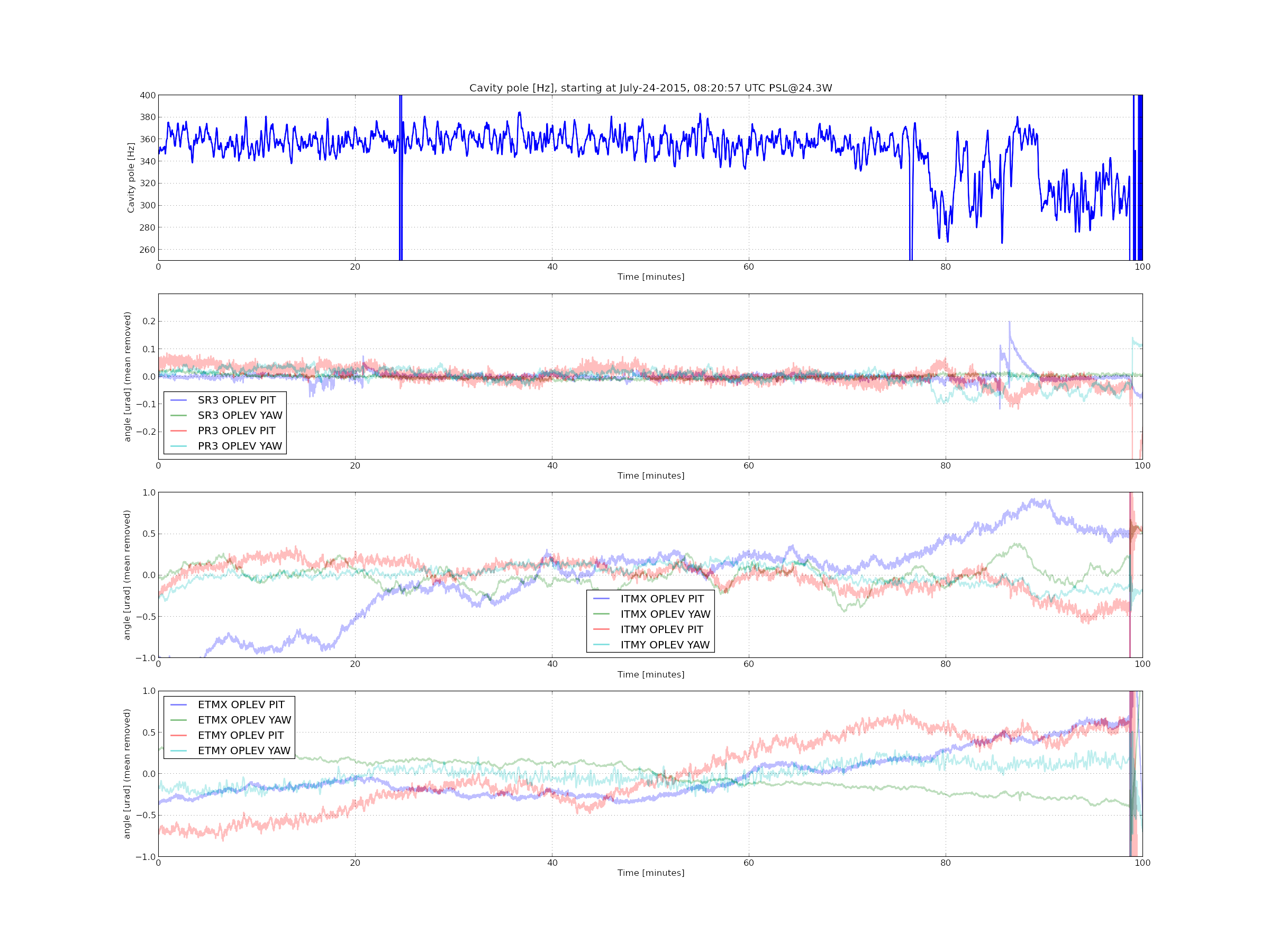Stefan, Evan
Summary
We temporarily switched back to the IFR as a sideband generation source, and then used it to drive the sidebands in frequency and amplitude. Then we looked at the coupling in OMC DCPD sum.
Details
We ran the spare LSC DAC channel (LSC-EXTRA_AO_2) into ISC patch cable R1 #11-4, which goes to ISC C4 #2-4. Then we sent this into the IFR's external modulation input.
First, we did the amplitude measurement. The IFR was set to dc-coupled AM with a nominal deviation of 10%. We drove 25 mV out of the DAC and watched the response in the OMC DCPD sum. The observed AM coupling is roughly flat from 300 Hz to 5 kHz, with a level of about 0.01 mA/RIN.
Next, we did the phase measurement. The IFR was set to dc-coupled FM with a nominal deviation of 1 Hz. We drove 100 mV out of the DAC and watched the response in the OMC DCPD sum. The observed FM coupling is roughly flat from from 300 Hz to 5 kHz, with a level of about 2×10−5 mA/Hz.
[An aside about the IFR actuation calibration: The IFR is designed so that in order to get 10% peak RIN, you must supply 1 V rms at the modulation port, which 1.41 V peak. Stupid stupid stupid. Anyway, I verified with an oscilloscope that the actuation coefficient was 0.068 RIN/V, which is close enough to the expected 0.071 RIN/V.
The same nuttiness applies to the frequency calibration: to get 10 Hz peak deviation, you must supply 1.41 V peak. However, Stefan and I measured this coefficient and found that it is really 3 Hz/V rather than 7.1 Hz/V. Measurement as follows:
- We beat the IFR and the OXCO against each other and looked at the mixed, low-passed output on a scope
- We adjusted the IFR frequency to match the OXCO as best we could.
- We applied 5 V dc from the DAC channel to the external input of the IFR, and measured the beat frequency (it was 14.8 Hz). This gives the acutation coefficient as 3.0 Hz/V.]
We can use the specified performance of the OCXO to compute the resulting oscillator AM and FM noise appearing in DARM. These couplings seem to be safely below the level of OMC DCPD sum, which is usually slightly less than 10−7 mA/rtHz above 500 Hz.
Since the specs are only given once every decade, any our measurements only have good coherence above 300 Hz and below 7 kHz, only the 1 kHz spec is really trustable here. I've tried to guess at a reasonable coupling level at 100 Hz and 10 kHz (based only on the TFs given above), but we should try to get better measurements before really trusting these numbers.
Amplitude noise:
| Freq. [kHz] | RIN [dBc/Hz] | RAM [1/rtHz] | Coupling [mA/RAM] | Noise in OMC sum [mA/rtHz] |
| 0.1 | −150 | 4.5×10−8 | ?0.02 | ?8.9×10−10 |
| 1 | −150 | 4.5×10−8 | 0.011 | 4.9×10−10 |
| 10 | −150 | 4.5×10−8 | ?0.02 | ?8.9×10−10 |
[In the above alog, I haven't distinguished between RIN and RAM. The TF takes relative fluctuation of the sideband amplitude (not the sideband power) to photocurrent.]
Frequency noise:
| Freq. [kHz] | Phase noise [dBc/Hz] | Phase noise [rad/rtHz] | Frequency noise [Hz/rtHz] | Coupling [mA/Hz] | Noise in OMC sum [mA/rtHz] |
| 0.1 | −140 | 1.4×10−7 | 1.4×10−5 | ?2×10−5 | ?2.8×10−10 |
| 1 | −160 | 1.4×10−8 | 1.4×10−5 | 2×10−5 | 2.8×10−10 |
| 10 | −165 | 8.0×10−9 | 8.0×10−5 | ?2×10−5 | ?1.6×10−9 |
Alexa and Daniel have also taken phase noise spectra of the OCXO, so this can be used to give a better estimate of the frequency noise.





















